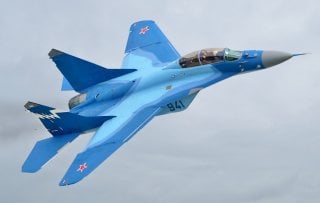The Secret Story of How America Purchased Russian MiG-29 Fighters
There's a right price for anything.
Key point: The Cold War was over and America wanted to study Soviet tech. Luckily for Washington, Moldova had the right planes and also needed cash.
When the Soviet Union collapsed in late 1991, the newly independent states within its former domain inherited enormous stockpiles of weapons the Red Army left behind.
One of the most interesting cases involved the air force of the tiny former Soviet republic of Moldova. The new republic’s inventory consisted of 34 MiG-29 Fulcrums, eight Mi-8 Hip helicopters and a handful of transport aircraft — a sizeable force for such a small state. To put Moldova’s size into perspective, the country’s population is smaller than the metro area of Portland, Oregon.
Moldova couldn’t afford to maintain the fleet and, to make matters worse, was in a deep recession. Meanwhile, the United States feared Moldova would sell the MiG-29s to Iran, which could use them to bolster its own fleet of Fulcrums. Washington was also wary that Moldova might pass the technology to Iran’s rivals since the fleet included 14 MiG-29C variants configured to deliver nuclear weapons.
So in 1997, the United States deployed its most powerful tool to get the MiG-29s for itself. That tool … was money. Washington bought 21 of the MiG-29s — including 14 C models, one B model and six A models — and flew them in pieces on C-17 transport planes to Dayton, Ohio.
Not only was purchasing the jets a good way of ensuring they did not end up in Tehran’s hands, it gave Washington an opportunity to inspect one of the most sophisticated Soviet jets ever built. In exchange, Moldova received $40 million in humanitarian assistance, some army trucks and other non-lethal equipment.
Moldova sold the rest of its air force to Eritrea and Yemen. The newly American MiG-29s would largely disappear into a maze of testing squadrons, intelligence centers and U.S. Air Force “exploitation facilities,” according to Air & Space Magazine.
The MiG-29 was a maneuverable, deadly aircraft for its time. Its Archer AA-11 missiles were sophisticated for the 1990s because of their ability to lock targets with a helmet-mounted cueing system at greater angles away from the jet’s nose than comparable American fighters. However, this advantage would collapse when the Pentagon introduced the AIM-9X missile in 2003 and associated helmet-mounted displays.
The Fulcrum further lacked the avionics and information management systems to tell the pilot what was going on outside the airplane, or where they were. A pilot literally had to look at paper maps to figure out their location. In general, the MiG-29 is a fine airplane engineering wise, but increasingly obsolete for aerial warfare in the 21st century without upgrades.
Incidentally, 1997 was the same year that another country outside the former Soviet bloc obtained MiG-29s. That country was Israel, which loaned three single-seat Fulcrums for a couple of weeks from an undisclosed Eastern European country.
Given that the MiG-29 was the most advanced jet fighter Russia ever gave to its Arab clients — Iraq and later Syria — the Israelis doubtlessly welcomed an opportunity to test and evaluate it themselves.
(Recommended: 5 Russian Weapons of War Turkey Should Fear)
Israeli pilots who tested out the aircraft were quite impressed. While different from the standard American-made jets they were accustomed to, they reported that the MiG-29 was easy to fly. Its computers for enabling landing if the pilot experienced difficulty were quite noteworthy.
This is due to the fact that this system “stabilizes the jet in case the pilot is affected by vertigo disease, and loses his orientation in space,” IAF Magazine noted. “Such systems do not exist in western aircraft, counting on the pilot to handle such situations independently.”
One test pilot concluded that the Fulcrum’s “abilities equals and sometimes even exceeds those of the F-15 and F-16 jets. The aircraft is highly maneuverable, and its engines provide higher weight to thrust ratio. Our pilots must be careful with this aircraft in air combat. Flown by a well trained professional, it is a worthy opponent.”
(Recommended: The F-23 - The Super Plane America Never Built)
Little wonder then why Washington seized the chance to assess these formidable fighters while simultaneously denying Tehran an opportunity to expand its own fleet. Today there are still MiG-29 operators all over the world — largely in Eastern Europe, the Middle East and South Asia.
Poland has some Fulcrums operating alongside their U.S.-made F-16 jets. Curiously, Israel signed a deal in August 2011 to refurbish, modernize and overhaul Poland’s MiG-29s. The source of Israel’s own Fulcrum lease is still unknown.
This first appeared in 2020 and is being reposted due to reader interest.

